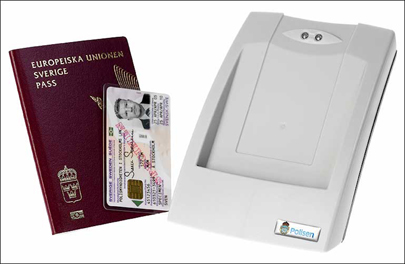Oct 19, 2005Sweden has started issuing RFID-enabled passports, or e-passports, fitted with RFID tags. Each tag is encoded with the personal details normally included in a passport—height, hair and eye color, and so forth—and with a digital photograph of the owner.
Swedish citizens applying for a passport must visit one of the country's 270 police stations, where they can complete a passport application and have a photograph taken. That data is then entered into a centralized government system and used to produce the e-passport.
Swenska Pass, a division of Setec, the systems integrator that developed the e-passport system, prints the passport and encodes the holder's data onto the tag's 64 kilobytes of memory. The document is then delivered to the police station, where the police and passport owner verify the accuracy of the encoded details.
"Before, you could have your passport picture taken at a local shop and use that, but now because of concern over potential manipulation of data, everything is centralized," says Bjoern Norinder, sales manager for ACG Identification Technologies, which developed and produced the RFID readers (interrogators) now installed at police stations across Sweden to support the new system. In total, 320 readers have been deployed so far.
The readers were modified from an ACG design by Arcontia AB, a contactless smart card reader supplier in RFID markets. The modifications were made at the request of the Swedish Police Service, which operates the nation's police departments. Designed with a custom housing, the readers can interrogate not only the e-passports but Sweden's new national ID cards, which are being fitted with the same RFID tags.
Swedish ID cards are not mandated, but they can be used in place of passports for identification when traveling within the country. "There is no requirement for Swedes to have an ID card," says Norinder, "but the idea is that in future, the card will be able to be used to verify identity when communicating with government agencies."
The readers connect to existing computers at each police station via a USB port and software drivers loaded onto the machine. The Swedish Police oversaw the installation of software to link the data collected with the Swedish government database, as well as the installation of the interrogators.
The readers were installed over the weekend of Oct. 1-2, and the first e-passports applications were taken on Oct. 3. Next year, the Swedish government expects to issue an estimated 500,000 e-passports.
The tags used in the new e-passports and ID cards operate at 13.56 MHz and comply with the ISO 7816 and ISO 1443A standards. To prevent a tag from being read from a distance or by unauthorized personnel, each e-passport is printed with a basic access code (BAC). This code must first be read via an optical character recognition (OCR) scanner or typed in manually into the RFID interrogator, which compares the data in the BAC code with that in the RFID tag. If they match, the RFID interrogator will gain access to all information stored on the tag.
According to ACG, the Swedish government is assessing bids from RFID suppliers for a project to deploy around 180 interrogators at Swedish consulates and embassies around the world, as a way to improve security and identification at those locations. The deployment of those readers is expected to start before the end of the year.
Further incentive for the e-passport deployment came from the U.S. government's planned US-VISIT (United States Visitor and Immigrant Status Indicator Technology) program. US-VISIT will comprise an integrated system to record entry into and exit from the United States, using biometric data to identify aliens and immigrants. That data will be stored on RFID chips attached to arrival and departure forms. In August, the U.S. government began testing the RFID system at several U.S. land border ports.
Sweden is set to extend its e-passport system to Swedish border control so the documents can be used for reentry into the country. However, no bids have yet been issued for that contract.


